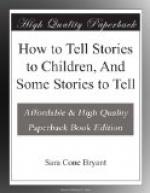That is, undoubtedly, rather an intangible beginning; it sets the root of the matter somewhat in the realm of “spirits and influences.” There are, however, outward and visible means of arriving at results. Every art has its technique. The art of story-telling, intensely personal and subjective as it is, yet comes under the law sufficiently not to be a matter of sheer “knack.” It has its technique. The following suggestions are an attempt to state what seem the foundation principles of that technique. The general statements are deduced from many consecutive experiences; partly, too, they are the results of introspective analysis, confirmed by observation. They do not make up an exclusive body of rules, wholly adequate to produce good work, of themselves; they do include, so far as my observation and experience allow, the fundamental requisites of good work,—being the qualities uniformly present in successful work of many story-tellers.
First of all, most fundamental of all, is a rule without which any other would be but folly: Know your story.
One would think so obvious a preliminary might be taken for granted. But alas, even slight acquaintance with the average story-teller proves the dire necessity of the admonition. The halting tongue, the slip in name or incident, the turning back to forge an omitted link in the chain, the repetition, the general weakness of statement consequent on imperfect grasp: these are common features of the stories one hears told. And they are features which will deface the best story ever told.
One must know the story absolutely; it must have been so assimilated that it partakes of the nature of personal experience; its essence must be so clearly in mind that the teller does not have to think of it at all in the act of telling, but rather lets it flow from his lips with the unconscious freedom of a vivid reminiscence.
Such knowledge does not mean memorising. Memorising utterly destroys the freedom of reminiscence, takes away the spontaneity, and substitutes a mastery of form for a mastery of essence. It means, rather, a perfect grasp of the gist of the story, with sufficient familiarity with its form to determine the manner of its telling. The easiest way to obtain this mastery is, I think, to analyse the story into its simplest elements of plot. Strip it bare of style, description, interpolation, and find out simply what happened. Personally, I find that I get first an especially vivid conception of the climax; this then has to be rounded out by a clear perception of the successive steps which lead up to the climax. One has, so, the framework of the story. The next process is the filling in.




